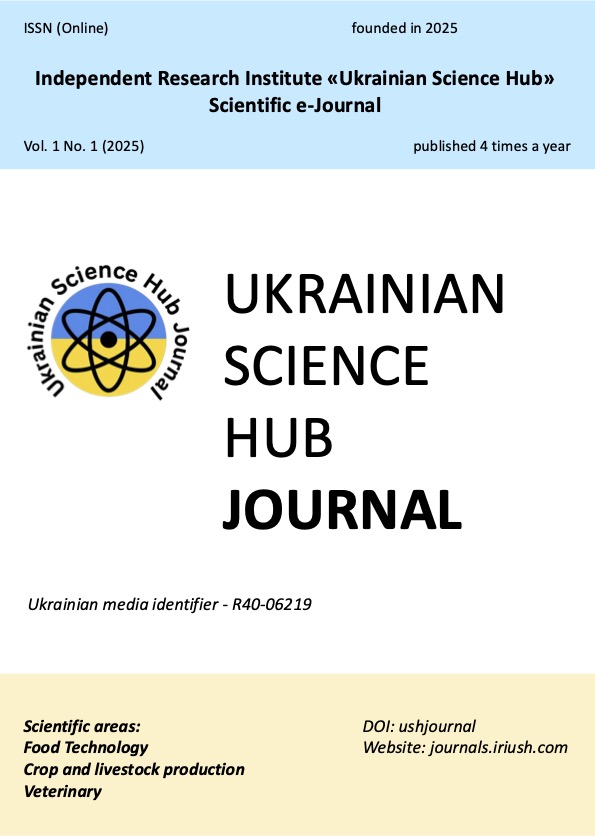ОБҐРУНТУВАННЯ СТАНДАРТИЗОВАНИХ ПОКАЗНИКІВ ДЛЯ ДЕЛІКАТЕСНИХ ПАШТЕТІВ
DOI:
https://doi.org/10.64378/iriush.journals.2025.1.2Ключові слова:
технічні умови, виробництво, безпечність, якість, нормативне регулюванняАнотація
Харчова промисловість України переживає активну трансформацію: зростають вимоги споживачів і посилюється потреба гармонізації з міжнародними стандартами. На цьому тлі розроблення технічних умов (ТУ У) для делікатесних паштетів набуває стратегічного значення, адже дає змогу підприємствам формалізувати вимоги до якості та безпечності, узгоджені із законодавством України, Codex Alimentarius і регламентами ЄС. У статті проведено аналітичний огляд норм (мікробіологічні критерії, маркування, гігієна) і обґрунтовано вимірювані показники для паштетів: волога ≤70,0% (оптимум 66–68%), жир 18,0–28,0% (оптимум 20–25%), білок ≥10,0% (оптимум ≥12,0%), сіль 1,2–1,8%, pH 5,7–6,4, a_w ≤0,98, крохмаль ≤5,0%; нітрит натрію: added ≤120 мг/кг (стерилізовані ≤82 мг/кг) і residual ≤25–50 мг/кг. Для готових до споживання продуктів встановлено: Listeria monocytogenes – «не виявлено у 25 г» впродовж строку придатності; Salmonella spp. – відсутність у 25 г; КМАФАнМ ≤1×10⁵ КУО/г; E. coli ≤10 КУО/г; коагулазопозитивні стафілококи ≤10² КУО/г. Дискусійний блок зіставляє наукові дані щодо ризиків (ботулінічні клостридії, B. cereus, Listeria) з доказами ефективності керувальних заходів (нітрит, швидке охолодження, температурні режими, GHP/HACCP). Показано потенціал рецептурних інновацій (використання рослинної сировини/м’яса дичини, збагачення волокнами, зниження жиру) для підвищення харчової та біологічної цінності без погіршення сенсорики. Запропонована структура ТУУ систематизує вимоги, спрощує аудит і сертифікацію, підвищує конкурентоспроможність та експортну готовність виробника.
Посилання
Antoniv, A., & Adamchuk, L. (2024). Investigation of technological parameters of manufacturing meat products from chicken fillet. Animal Science and Food Technology, 15(2), 9-22. doi: 10.31548/animal.2.2024.09.
Bilko, N. V., & Adamchuk, L. O. (2024). Principles of Developing Technical Conditions for New Products. Retrieved from https://elartu.tntu.edu.ua/bitstream/lib/45707/1/Збірник%20праць%202024.pdf#page=278
Commission Decision (EU) 2024/1225 of 30 April 2024 concerning national provisions notified by Denmark on the addition of nitrite to certain meat products. https://eur-lex.europa.eu/legal-content/EN/TXT/PDF/?uri=OJ%3AL_202401225&utm_source=chatgpt.com
Davidescu, M. A., Panzaru, C., Ciobanu, A., Madescu, B. M., Bolohan, I., Porosnicu, I., & Usturoi, A. (2024). Analysis of quality of turkey pâté: organoleptic, physicochemical and microbiological evaluation. Scientific Papers Animal Science and Biotechnologies, 57(2), 170-175.
Hashchuk, O. I., Moskalyuk, O. E., Medianyk, M. O., & Lipinskyi, K. A. (2022). Prospects for the development of innovative formulations of pates as complete products of health nutrition. Retrieved from https://dspace.nuft.edu.ua/server/api/core/bitstreams/cd76fb4b-7d1c-4c53-be77-0aa114df5657/content.
Isaković, S., Karahmet, E., & Toroman, A. (2021, September). Testing of physico-chemical and sensory properties of pate. In 31st International Scientific-Expert Conference of Agriculture and Food Industry (p. 106).
Jenson, I., & Sumner, J. (2012). Performance standards and meat safety—Developments and direction. Meat Science, 92(3), 260-266. https://doi.org/10.1016/j.meatsci.2012.04.015
Kapustyansky, S. V., & Tkach, N. I. (2020). Improvement of liver pate technology through the use of carotene-containing raw materials. Retrieved from http://dspace.puet.edu.ua/bitstream/123456789/8136/1/Магістерська%20Капустянський%20на%20репозитарій.pdf
Manap, K., Serikkyzy, M. (2022). Production of ostrich meat pâtés: Design of a food safety management system. Food Science and Technology International, 29(8):847-856. https://doi.org/10.1177/10820132221124195
Medvedyuk, D. O. (2024). Improvement of the method of production of pate for health purposes using germinated lentil and buckwheat grains. Retrieved from https://dspace.nuft.edu.ua/server/api/core/bitstreams/7a8fed27-1474-446f-9981-34209454a939/content
Poumeyrol, G., Rosset, P., Noel, V., & Morelli, E. (2010). HACCP methodology implementation of meat pâté hazard analysis in pork butchery. Food Control, 21(11), 1500-1506. https://doi.org/10.1016/j.foodcont.2010.03.017/
Prylipko, T. (2019). Quality Control, Safety of Raw Meat and Turkey Meat Pate and Justification of Recipes and Sterilization Regimens. Podilian Bulletin: Agriculture, Engineering, Economics, 1(31), 23–29. https://doi.org/10.37406/2706-9052-2019-2-3
Rupa, T. A., & Israelyan, V. M. (2024). Improvement of the Technology of Pates from Non-Traditional Raw Materials. Scientific Achievements in Solving Actual Problems of Production and Processing of Raw Materials, Standardization and Food Safety: Collection of Papers on the Results of the XII International Scientific and Practical Conference of Scientists, Postgraduates and Students (Kyiv, April 18, 2024 – April 19, 2024). Kyiv: RVV NUBiP of Ukraine, 456 p.
Seleznyova, О. І. (2021). Expansion of the range and improvement of pate technology from non-traditional raw materials. Retrieved from https://dspace.nuft.edu.ua/server/api/core/bitstreams/f6df4841-f98a-4cf3-bf88-8a3501f3ad9d/content.
Skvirenko, E. Y. (2025). Introduction of innovative technologies for the production of pates using edible flour for establishments HoReCa. https://dspace.nuft.edu.ua/server/api/core/bitstreams/37d31cb9-8b91-44fd-8355-ddf830a53d26/content.
Trindade, P. C. O., Santos, B. A. d., Hollweg, G., Correa, L. P., Pinton, M. B., Padilha, M., Payeras, R. H. Z., Rosa, S. C., Cichoski, A. J., & Campagnol, P. C. B. (2023). Pea Protein Isolate as a Meat Substitute in Canned Pork Pâté: Nutritional, Technological, Oxidative, and Sensory Properties. Foods, 12(18), 3486. https://doi.org/10.3390/foods12183486.
Завантаження
Опубліковано
Номер
Розділ
Ліцензія

Ця робота ліцензується відповідно до ліцензії Creative Commons Attribution-NonCommercial-ShareAlike 4.0 International License.


